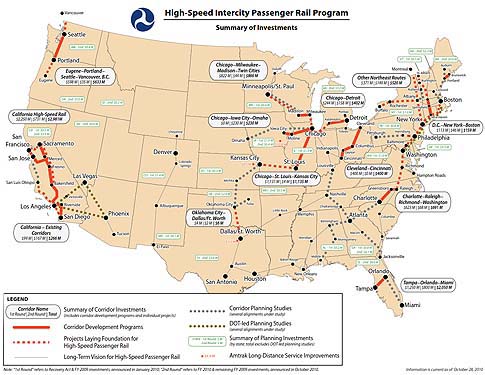
Click pic to embiggen into a pdf
This might be the holiday travel season that gets U.S. high-speed rail projects moving.
Faced with invasive airport screenings and traffic-choked highways, Americans may say “enough!” and demand a transportation alternative that’s already embraced by America’s biggest competitors.
While we’re still waiting for construction to begin on the first mile of true high-speed rail in the U.S., other countries aren’t sitting still.
[…]
But next time you experience the full-body airport scan – or the alternative pat-down – think for a moment about a fast, comfortable ride on a high-speed train you boarded without having to compromise your privacy and dignity.
This obviously was written before the last story (shown below) hit.















Some of the problems to be figured out for USA high speed.
1. the USA isnt FLAT, except for the central/plains area. Im not talkin about HILLS, Im talking about 3000-5000 foot grades…
2. Flood plains in the central USA…
3. FARM communities..
4. MOST major Cities/communities, are 600-800+ miles apart. Interlinking major destinations? HA!.
5. most of these routes look as if, By the time you get up to speed…You are stopping.
6. then comes the FUN PART.. SHORT LINES, CITY TRANSPORT.. to get you 1/2 way NEAR your destination.
7. COST. EVERY major nation wide advancement from TRAINS, ROADS, ELECTRICITY, DAMS, …. were all PAID FOR BY ???…
That looks pretty cheap to me. That is distance, plus costs for displacing people in the path.
Imagine having real options to travel quickly between major cities. That would create competition between rail and air. Each could seek its natural place.
The problem is that this “high speed” rail is anything but.
Seriously if you can hop in your car, and beat the high speed train to its destination, people are going to drive.
I have been to Europe many times, and yes, they have a nice high speed rail link, but they also don’t have 300 – 600 miles between major cities, with large roving animals. Imagine a high speed train going 200 mph, and hitting a bunch of dear on the track. If it doesn’t derail it won’t be so bad, but if it does…..
Rail is the logical thing to do for all the reasons stated. The lobbyists prevent this from moving forward.
We need visionaries to solve our long term mass transit system. The above dipshit excuses show why we can’t move forward.
God, please save us from the dipshits. Speaking of which, a HS train runs on an electrical grid (magnetic). It’s not a diesel powered choo-choo train you dingbats.
Dipshit Hint: An electrical grid can be powered by all forms of energy.
#35
Oh. The power plans must run off kittens and unicorns but certainly not fossil fuels.
#35
There is a solution, but would add about 10 times to the price.
SUSPEND IT
or
BURY IT.
If you bury it, you will have TONS AND TONS of problems as well as aquifers, HARD ROCK, and it would take YEARS OF DIGGING to finish.(didnt stop the brits)
Suspend it?
Its a solution, but requires TONS more work also. Not really designed for Heavy cargo transport. It would have to be a flexible/floating track..as concrete and Metal change in seasons, differently.(currently BELOW zero here)
But, the RAIL CORPS are not the ones TRYING to pay for this…YOU ARE.
I admit it – I’m an easy sell on the train thing. I’ve spent time in countries with high speed rail as a backbone of solid mass-transit. I’m for them. I hate driving, especially in traffic. Traveling with groups in Japan (for example) across country is so much more productive and relaxing. (Just don’t get stuck in a smoking car – WHOA.)
When proponents like me advocate examples of where it works, though, we would be dishonest if we forget that high speed rail:
1. Has its advantages diminishes rapidly against cars for trips under an hour or so, and against planes for trips beyond 4-6 hours.
2. Is less cost effective in less population dense areas.
3. Comes a high fixed initial cost, and are less flexible/adaptable to changing circumstances.
4. Suffers greatly if the rest of the mass-transit infrastructure isn’t up to par when you get to your destination.
On that last point, I’m not sure we’re there in most of the country. (And I still love trains, because I’ve seen what happens if you can work all angles and make them a part of a compelling mass-transit combination!)